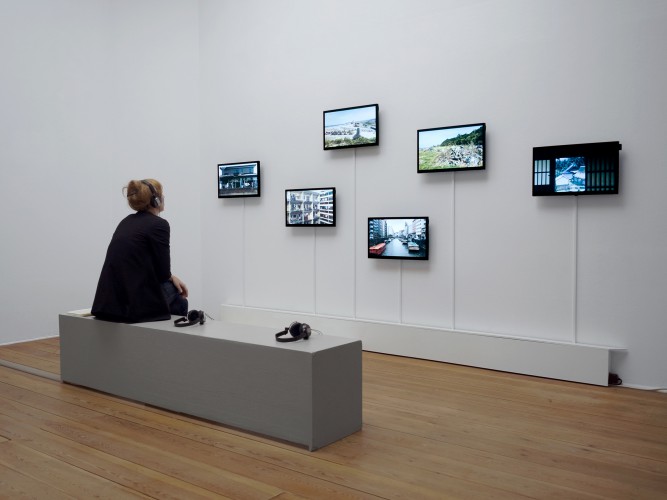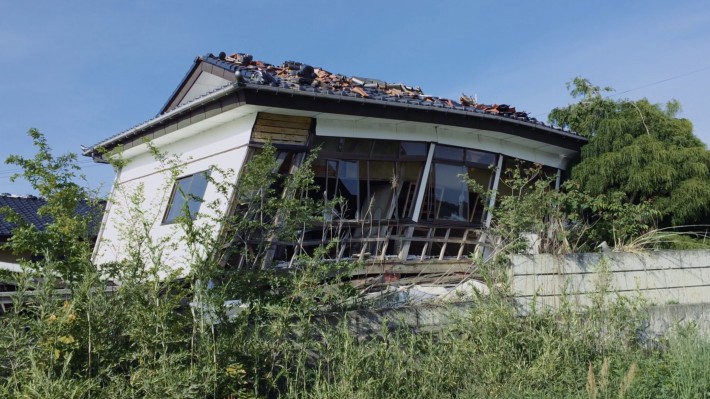Video installation: Precarious Spaces, Radiant Days, 2016
2016, six channel HD video installation, stereo sound (voice over), 15 mins loop
Direction, script and narration: Malin Pettersson Öberg
Watch video documentation

During the spring of 2016 I spent three months in Japan in order to research and film the effects of the 2011 earthquake, tsunami, and nuclear accident in Fukushima, notably on the built environment and on people’s lives. I also enquired into the historical background to nuclear power in Japan, in all its complexity and ambiguity, with visits to significant places such as Hiroshima and Fukushima, along with interviews with academics, journalists and artists, and research at the Japan Foundation Library. During my process I received invaluable help and support from a number of independent artists, curators, writers and art initiatives in Japan, along with funding bodies such as the Helge Ax:son Johnson Foundation, The Swedish Arts Grants Committee and The Swedish Institute.
Back in Sweden I developed a six channel video installation for the exhibition ‘Species of Spaces 1974’ at Uppsala Konstmuseum (2016), a text for the anthology ‘Species of Spaces 1974 – An Accommodation of Retained and Forgotten Locations’ (Arvinius + Orfeus, 2016), and a lecture in relation to the exhibition. Through seemingly still video images, I tried to approach the paradoxical feeling of time having stopped at these places, and of traveling through a beautiful, blossoming, landscape, knowing that it is contaminated with radiation. I later developed a one channel film and a performance for the event ‘To Visit, Research and Trace: How to Represent Invisible Spaces’ at Fylkingen in Stockholm (2016) and a three channel video installation and conversation with an archaeologist for a solo exhibition at Vallentuna Kulturhus (2018).
Malin Pettersson Öberg
2019

Malin Pettersson Öberg has explored her interest in what Georges Perec describes as ‘uninhabitable spaces’; places affected by environmental disaster or human irresponsibility. Such an unstable and precarious place of today is the evacuation zone surrounding the Japanese nuclear power plant Fukushima Daiichi. Her silent video montages, accompanied by a voice-over, emphasize how time has frozen in these places. With the sharp and distanced observations of a voyager, Pettersson Öberg creates associative links between the Mitsubishi headquarters in the financial districts of Tokyo, which was bombed by a revolutionary group in 1974, socially exposed areas inhabited by temporary nuclear power plant workers, and the ‘forbidden zone’. The artist asks questions about time, space, transition and representation. In a reflection on the Japanese concept of space, where darkness and light, impermanence and stability, seem to be interchangeable, she quotes Roland Barthes: ”to visit a place for the first time is thereby to begin to write it.
Rebecka Wigh Abrahamsson, 2016
Intendent Uppsala konstmuseum
P R O D U C T I O N
Direction, camera, script and editing: Malin Pettersson Öberg
Voice recording: Johan Chandorkar, Pernilla Ståhl – Umami Produktion
Post production: Nils Fridén – Velourfilm
Translation and proofreading: Malin Pettersson Öberg and Ola Ståhl
Technological support and installation: Eidotech (Berlin), Martin Wallin (Uppsala konstmuseum)
Video documentation: Timo Menke
T H A N K Y O U
Hiroshi Ashikaga, Yoi Kawakubo, Atsushi Sakamoto (Fukushima Prefectorial Art Museum), Ikumi Aihara, Kaoru Kumagai (Kotobuki Alternative Network), Prof. Tsutomu Tomotsune and Daizo Tanaka (Tokyo University of Foreign Studies), the staff of Youkobo Art Space, Tokyo, William Andrews (Throw Out Your Books), The Japan Foundation Library, Tokyo, Raoul Délémazure (Association Georges Perec), Paris, Filmform, Stockholm, Rebecka Wigh Abrahamsson (Uppsala konstmuseum), Hiroko Tsuchimoto and Per Åhlund (Fylkingen/EMS), Michiko Inoue, Cecilia Björk, and the artists behind ‘Species of Spaces 1974′: Kristina Bength and Cecilia Darle.
P R E S S
Download film dialogue and production information (Malin Pettersson Öberg, EN)
Download press review Uppsala Nya Tidning, 2016.09.28 (Susanne Sigroth-Lambe, SE)